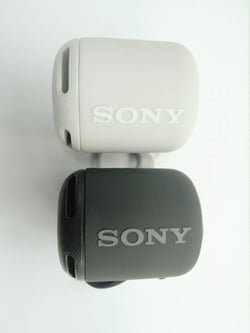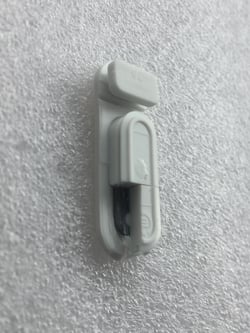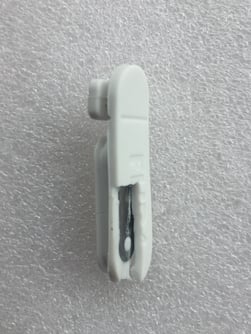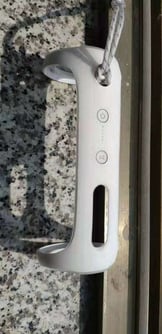Overmolding is a special plastic molding process where one kind of plastic material is injected and formed in a plastic mold followed by a secondary molding mold to be injected into the same kind of material or another plastic material. Overmolding can be used to make the surface of the product soft or to increase the functionality of the product to add value. The overmolding technology is known for creating a "soft surface" as the final result. Besides this, it has many other applications, such as better ergonomics, two-tone appearance, brand identity, and feature improvements. With this technology, you can also increase the functionality of your products with features such as noise reduction, shock absorption, water resistance, and increased durability that can create significant added value.




TPE overmolding process
Thermoplastic Elastomer is called TPE for short. It is a functional material with both rubber elasticity and plastic stiffness which can be directly injected and extruded. TPE-S (Polystyrene TPE) is compound modified with SEBS or SBS as the basic material and it is commonly used for overmolding among the TPE material. TPE-S is also commonly referred to simply as TPE or TPR in the elastomer industry.
The properties of TPE
TPE is currently heavily applied in the overmolding process. Because the TPE material has good slip resistance and an elastic touch, it can improve the touch feeling of the product and enhance the grip. TPE can also be adjusted to the appropriate hardness (hardness range Shore 25-90A) and physical property (such as abrasion resistance, scratch resistance, adhesion index, melt index, etc.), as needed, depending on the physical properties of the products. A variety of possible material applications are available for different products.
Some common uses for TPE overmolding are handles, grips, electronic materials, etc where the physical properties of the material can add significant value to the product. Most of the products end up in developed markets like the United States, Japan, and the European Union since TPE is a green and environmentally friendly raw material. This material contains no phthalates and none of 38 SVHC substances of high concern for REACH. TPE is also halogen-free. It can pass the tests of ROHS, REACH, NP, EN71 and PAHS, and it can fully meet the environmental requirements of developed countries and regions such as the United States, Japan, and the European Union.
Primary Mechanism
TPE overmolding takes advantage of their similarity to soft and hard rubber when they soften and melt. The compatibility depends mainly on the solubility parameter (SP) of the material. The closer the solubility parameter is, the better the compatibility of the two materials is. When the two materials come into contact, it creates a bonding layer on the contact surface between the hard rubber and the soft rubber, which greatly improves the rubber adhesion between the TPE soft rubber and the hard plastic. The fake rubber coating has no influence on the compatibility of soft rubber and hard rubber. The compatibility of the material is like mechanical glue. The design of the mold, the product
Processing Technology
TPE overmolding is generally a secondary injection molding process. The first molded part is fixed onto the overmolding mold where the TPE soft rubber is injection molded onto the hard rubber parts at a suitable temperature, then cooling as a single product. The injection molding temperature of overmolding is different depending on the hard rubber material. Because the temperature should be considered to soften both the hard rubber and the TPE soft rubber, the two materials can be made compatible at the contact surface. In order to achieve the true overmolding effect, the injection temperature of the TPE overmolding PP material is usually around 170-190 degrees Celsius and the overmolding ABS material is about 220-220 degrees Celsius where the temperature of the overmolding PC material is slightly higher than the injection molding temperature of the overmolding ABS. For overmolding PA nylon, the injection temperature can reach 240 degrees Celsius.
Common materials
TPE soft rubber is used as a soft rubber outer cover. The common hard materials are mainly plastic while others can be metal and woven fabric. TPE and woven fabric are mainly used for luggage products. True rubber coating is more common in overmolding and two-color injection molding, which means the main material of TPE overmolding is plastic. TPE can be firmly bonded to some commonly used general plastic PP, GPPS, HIPS, and ABS as well as mixed plastic PC, PC/ABS, PA, and their modified materials. The adhesion of TPE to POM (polyoxymethylene) is still a problem in the elastomer industry. Since the solubility parameter SP (22.6) of POM is far different from SP (7.2-7.6) of TPE, these two materials have no compatibility. And at present, there is no suitable compatibilizer for promoting good adhesion between the two.
Areas of Note
- The compatibility of TPE and hard rubber structural parts should be matched. The molecular solubility should be close, so the compatibility of molecules is good.
- In the design, it is necessary to avoid sharp corners as much as possible to ensure good contact between TPE and hard rubber parts and improve bonding effect.
- Use proper exhaust way to avoid gas in the mold cavity.
- Balance the thickness of the TPE with the expected tactile sensation.
- Keep the rated temperature of the TPE melt to ensure the bonding effect.
- TPE material overmolding needs to be processed after baking to can reduce the watermark on the surface of the product to obtain the uniform color of the surface.
- The carrier resin of a selected masterbatch should be compatible with the TPE and structural materials.
- Special treatment is required for the smooth surface to increase the bonding surface between the soft rubber and the hard rubber thereby enhancing the bonding effect.
- TPE should have good fluidity because of the small ratio of thickness to flow length - TPE usually needs to flow through a long path and the thin wall area to fill the mold.
- Flow length to thickness (L/t) ratio of TPE is less than 150:1.
- A good adhesive is critical.
Defect handling
Lack of compound and breach - Increase the processing temperature; increase the injection pressure; improve material flow.
Trailing edge, overflowing - reducing the injection temperature; increasing the clamping force; reducing the injection pressure; reducing the fluidity of the formulation.
Rough surface, lacking brightness - increase injection molding temperature; bake and reduce raw material moisture.
Poor viscosity - sufficient baking before injection; increase injection temperature; adjust the formula.
Injection molding deformation of the product - strengthen the mold cooling; properly extend the clamping time.
Product sticking on mold - adding mold release agent or lubricant (for internal lubricant - be careful about mold release agent amount, in case of mold release agent precipitation and migration.
Posted by Bo Li

Bo breaks down complex projects into turnkey-able parts. Educated in Optical Engineering, he is actually a veteran in plastic manufacturing.
